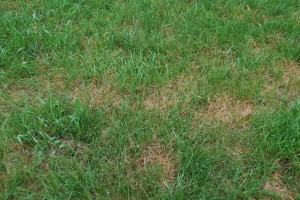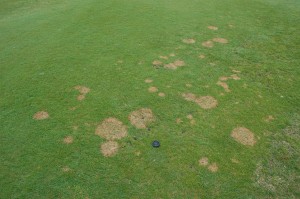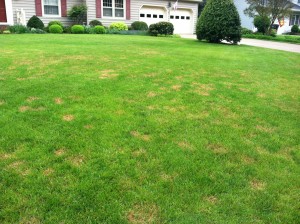Red thread has been festering in turfgrass for some weeks now, but really blew up over the last few days. As long as there is plenty of moisture – light rain, heavy fogs, dew – and optimal temperatures (60ºF to- 75ºF) – the fungus that causes red thread, Laetisaria fuciformis, will tear up susceptible grasses.

Pseudosclerotia (red threads) of Isaria fuciformis are clearly evident on red thread infected fine fescue. Photo: Sabrina Tirpak, Rutgers PDL
Red thread attacks all cool-season turfgrass species, but prefers perennial ryegrass and some of the fine-leaved fescues. Disease is most severe in poorly maintained or low input turf stands. Low cutting height, drought stress, thatch and compaction, and low-fertility input, particularly nitrogen input, may all impact turf vigor, which can predispose grass to attack.

Red thread on poorly maintained ryegrass/bluegrass/fine fescue turf. Photo: Richard Buckley, Rutgers PDL
Generally, our first approach to red thread management in landscape turf is to increase the nitrogen input on the site. The addition of as little as a half pound of nitrogen per 1000 square feet can push the grass to grow faster then the fungus can blight leaves. Most certainly, if you have red thread now, a little shot of N will not hurt. Just be careful not to over stimulate the grass going into the summer. Moving forward, closely evaluate your overall program (how about a soil test?) and make the adjustments necessary to maximize turf health. But what if your management plan is good and you still have red thread?
Of course, the fungus didn’t read the book, so do not be surprised to see the disease in well maintained swards. Even in these cases, bringing precision to your management program is essential to reducing the impact of this disease. Perhaps overseeding thin areas with an improved (and red thread resistant) ryegrass or a change in irrigation scheduling or raising your cutting height might do the trick?
If all else fails, however, there are many fungicide materials labeled for red thread that will provide adequate control. For those of you managing high-value landscape turf without access to spray rigs, be aware that there are several granular fungicides on the market that will work for this disease. In fact – and I do have some caveats about combination products – there are granular materials on fertilizer carriers, so if you need it, one can get a little disease protection right along with your shot of N.



